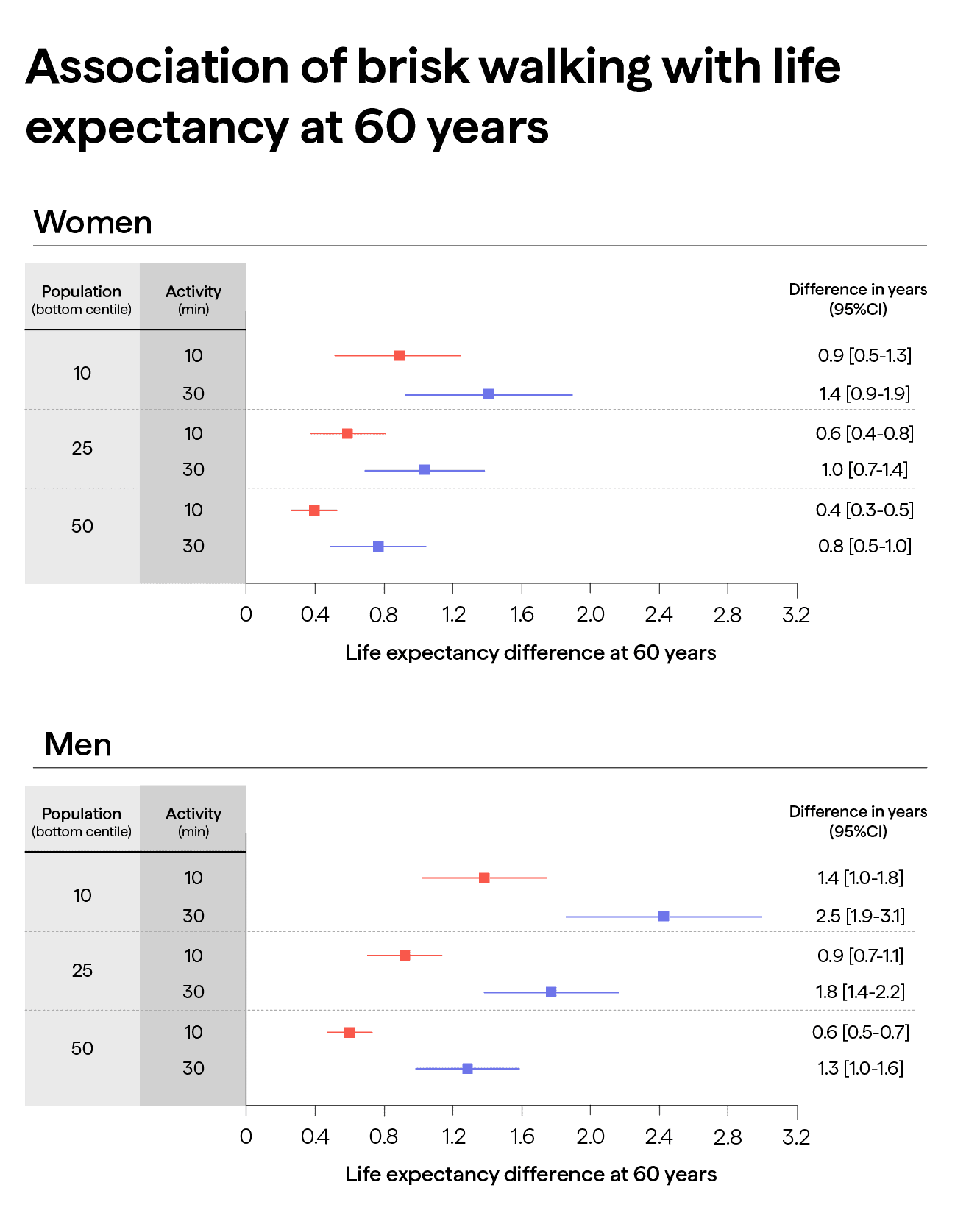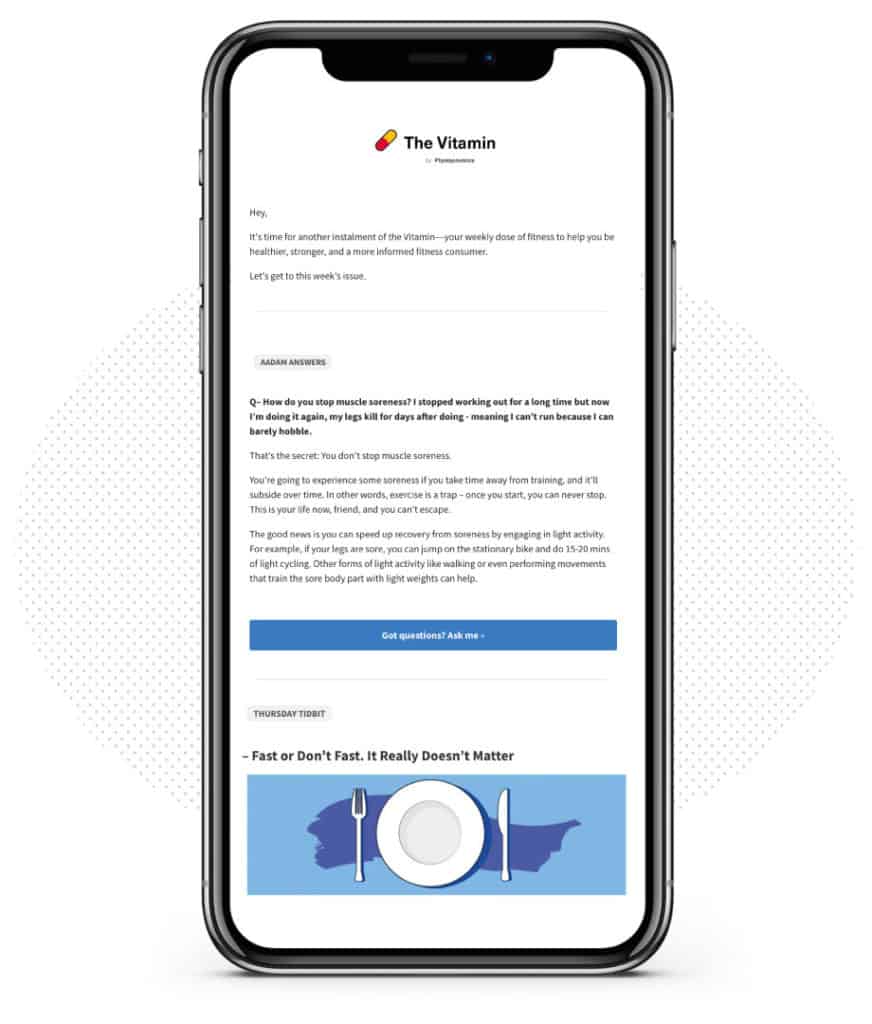Quick note: this post is taken from the Vitamin. Every Thursday, I drop some knowledge bombs on your face to help you reach your goals faster while avoiding all the bullshit.
We know that exercise – and more movement in general – is good for us. But does it matter how we move? Should we focus on getting more steps throughout the day, or is it better to work up a sweat with intense exercise? A recent study explored this question. 1
The what: Scientists analysed accelerometer data from over 71,000 middle-aged adults (~57% women, 43% men) in the UK Biobank study. The goal? To see how physical activity volume (how much you move) and intensity (how hard you move) affect how long someone will live.
In particular, they looked at two metrics:
- Volume: Total movement throughout the day, measured in fancy science units called milli-gravitational units (mg).
- Intensity: Captured using the Intensity Gradient (IG). This measures how your activity is spread across intensity levels:
- A steep IG means most of your movement is low effort (think shuffling from your desk to the fridge or doing light chores).
- A shallower IG means you’re spending more time in moderate-to-vigorous activities (like brisk walking or running). You’re not just moving––you’re moving hard.
- A steep IG means most of your movement is low effort (think shuffling from your desk to the fridge or doing light chores).

The researchers analysed the 10th to 90th percentiles of activity levels for men and women, estimating life expectancy at age 60 based on participants’ physical activity volume and intensity, adjusted for health factors like BMI, illness, and lifestyle habits (e.g., smoking, diet).
What did they find?
• Higher physical activity volume and intensity = longer life
A higher volume of movement was associated with an increased life expectancy, and doing the same volume at a higher intensity further increased life expectancy. When comparing the highest to lowest activity levels–
- Women in the highest 10% of activity (volume+intensity) lived 3.4 years longer than those in the lowest 10%.
- Men in the highest 10% lived 4.6 years longer than those in the lowest 10%.


• Intensity seemed to benefit women more than men
Women who did more intense activity at any given level of activity volume lived at least 1.7 years longer than women doing the same amount of volume but at a lower intensity. While there was a similar trend for men, this tapered off after about the 50th percentile; intensity seemed to matter less if men accumulated enough total activity volume (you can see this in the image above).
• Every bit helps
The researchers also examined how adding 10 or 30 minutes of daily brisk walking affected life expectancy for individuals starting at low physical activity levels, based on the bottom 10th, 25th, and 50th percentiles of physical activity volume and intensity, adjusted for various factors (e.g., health conditions, diet, smoking).
For Women:
- 10th Percentile (Lowest PA Levels):
- Adding 10 minutes of brisk walking increased life expectancy by 0.9 years.
- Adding 30 minutes increased life expectancy by 1.4 years
- 25th Percentile:
- 10 minutes of brisk walking adds 0.6 years
- 30 minutes adds 1.0 years
- 50th Percentile:
- 10 minutes adds 0.4 years
- 30 minutes adds 0.8 years
For Men:
- 10th Percentile (Lowest PA Levels):
- Adding 10 minutes of brisk walking increases life expectancy by 1.4 years.
- Adding 30 minutes increases life expectancy by 2.5 years
- 25th Percentile:
- 10 minutes of brisk walking adds 0.8 years.
- 30 minutes adds 1.8 years.
- 50th Percentile:
- 10 minutes adds 0.6 years.
- 30 minutes adds 1.3 years.

What does this all mean?
Let’s pump the brakes for a second and talk about what ‘harder’ means because how the fitness industry defines intensity isn’t how world health organisations define it, especially in the context of general health (versus sports performance, for example).
Generally, ‘moderate intensity’ is defined as any activity where you can talk but not sing for the entire duration (e.g., brisk walking), and ‘vigorous intensity’ is any activity where it’s difficult to say more than a few words before pausing for a breath (e.g., running).
It might be tempting to think the ‘intensity gradient’ refers to ‘vigorous activity’, but that isn’t the case. To quickly recap–
The intensity gradient describes how physical activity is distributed across different intensity levels.
- A steep intensity gradient means most of your movement is low effort—like casual walking or getting up for coffee—with very little time spent in higher-intensity activities.
- A shallower gradient indicates a more balanced distribution across intensities, with more time spent doing moderate or vigorous activities.
As such, the intensity gradient isn’t just about an all-out effort that involves puking out a lung.
Instead, it reflects a more holistic view of movement patterns across the day and emphasises that even moderate activities, when sustained over time, can create meaningful changes in overall activity distribution and, by extension, overall health.
For example, the same increase in overall activity could come from very different combinations of activity. 2
- Three hours of slow walking (~2mph or 3km/h) or 75 minutes of brisk walking (~3mph or 5km/h) could have the same effect on average acceleration.
- Alternatively, someone might achieve the same effect with 16–17 minutes of slow running (5mph or 8km/h) or 13 minutes of medium running (6mph or 10km/h)
So yeah, someone with a shallower intensity gradient is engaging in activities at a higher intensity––cool, got it––but we don’t know how their intensity is distributed. Are they going for a slow jog, a fast(er) run, walking at a gentle pace for extended periods or maybe at a brisk pace? All of the above? This matters because without knowing this, we can’t give out hyper-specific cardio recommendations (like so many people on social media do these days).
While a single study can’t prove cause and effect, it does jibe with other research. To highlight a few–
- Schwendinger et al. 2025 3 found higher intensity and volume were independently linked to lower all-cause mortality, with intensity appearing slightly more important than volume (note – this study also used the intensity gradient).
- Tarp et al. 2024 4 found that total physical activity was associated with a lower mortality risk, with “a small added benefit if the same amount of activity is performed with a higher intensity.”
- Schumacher et al. 2024 5 looked at the association of the relative intensity of physical activity with the risk of cardiovascular disease and all-cause mortality in a sample of ~5000 women and found both light and moderate-to-vigorous physical activity had protective effects.
- Lee et al. 2022 6 found the nearly maximum association with lower mortality was achieved by performing 150 to 300 min/wk of vigorous physical activity or 300 to 600 min/wk of moderate physical activity, or an equivalent combination of both.
- Strain et al. 2021 7 highlighted that higher volumes of physical activity energy expenditure (PAEE) reduce mortality but achieving this through higher-intensity activities (e.g., brisk walking for 7 minutes vs. strolling for 12 minutes) is even more effective.
- Wang et al. 2021 8 found both moderate-to-vigorous and vigorous activity provided a similar 20% reduction in the risk of all-cause mortality. However, higher levels of VPA (≥150 minutes/wk) offered a further 17% reduction in mortality risk compared to 150–299 minutes of MVPA alone.
- Ekelund et al. 2019 9 concluded that any amount of physical activity, regardless of intensity, significantly lowered the risk of death, with the biggest benefit seen at around 24 mins/day of moderate-to-vigorous activity.
- Saint-Maurice et al. 2018 10 showed that increasing light physical activity was associated with a reduction in mortality risk. However, moderate-to-vigorous physical activity had a slight edge at an equal volume of physical activity.
And, of course, we have all of the step count research suggesting a higher step count (i.e. more movement) is linked to better health outcomes.
So, move more or move harder?
Both matter.
Start by moving more and then scale up the intensity as needed. Practically, this is what I’d recommend.
- Start with movement. If you’re currently doing fewer than 5000 steps/day, aim to increase this to 7-10k daily steps. Walking more is strongly associated with lower mortality and CVD risk.
- Break up sitting time. Sitting for long periods can counteract the benefits of movement. Ahmadi et al. 11 showed that a high step count is even more effective if you spend less time sitting. Similarly, Koemel et al. 12 found that short bursts of vigorous incidental activity—like climbing stairs quickly or running for the bus—can significantly reduce cardiovascular risk. For instance, just 4 minutes of these activities or 30 minutes of moderate daily movement can offset the harmful effects of prolonged sitting.
- Increase the Intensity: Once you’re moving regularly, pick up the pace. Turn a casual stroll into a brisk walk (3-4 mph/4-6 km/h), take the stairs, walk uphill, etc.
- Incorporate vigorous activities: Once the above are in place, congrats! You’re pretty much close to maxing out the health benefits. But if you want to take it a step further, you overachiever you, consider adding some ‘vigorous’ activity into your week that elevates your heart rate. Importantly, choose something you enjoy (or at least tolerate for the long term). For example, I hate running. I don’t care what health benefits I might accrue––I ain’t running. So, instead, I get my ‘vigorous’ activity by carrying my childhood trauma –shit, I mean, wearing a 25kg/55lb vest and walking for 60-70 mins a few times per week.
TL;DR
- A recent study found that more movement is good for you (duh), and performing the same volume of physical activity at a higher intensity might confer even greater longevity benefits (e.g. a brisk walk or slow jog versus a casual stroll).
- However, this effect was greater for women than men. Women who did more intense activity at any given level of activity volume lived at least 1.7 years longer than women doing the same amount of volume but at a lower intensity.
- If you’re currently sedentary, adding a 10-minute brisk walk could add almost a year to your life. Extending this to 30 minutes could add an additional 1-2 years. You know, if you’re into the whole living longer thing.
- We see a similar pattern when looking at the broader research: Reducing sedentary time and integrating more movement into your day can reduce the risk of all-cause mortality and CVD risk, with intensity of movement providing slightly further benefits.
- Sit less, move often, try making some of this movement higher intensity, and don’t get caught up on hyper-specific cardio protocols. Implement an activity that works for you and that you can stick to for the long term.
Thanks for reading. If you enjoyed this, you’d love the Vitamin

95% of my new content is only sent to my email list. One email every Thursday, filled with actionable, evidence-based fitness advice to help you with your goals. If you enjoyed this, you’ll love my emails. You can learn more and subscribe for free here.